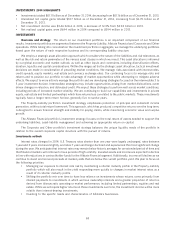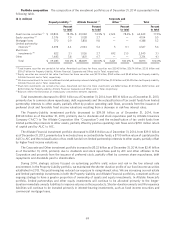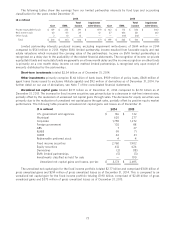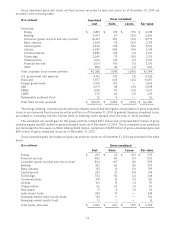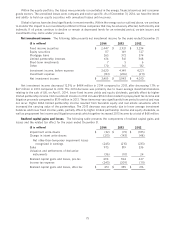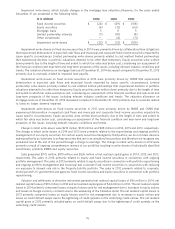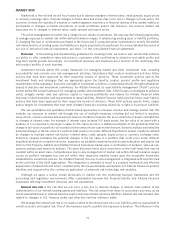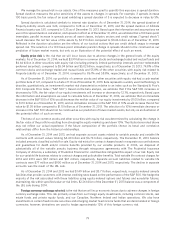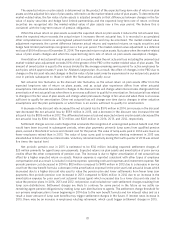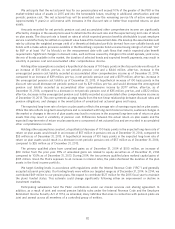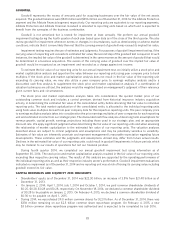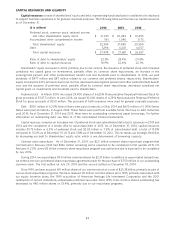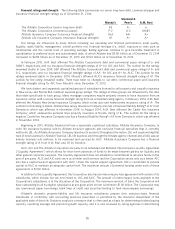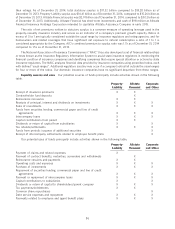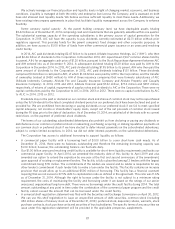Allstate 2014 Annual Report Download - page 177
Download and view the complete annual report
Please find page 177 of the 2014 Allstate annual report below. You can navigate through the pages in the report by either clicking on the pages listed below, or by using the keyword search tool below to find specific information within the annual report.MARKET RISK
Market risk is the risk that we will incur losses due to adverse changes in interest rates, credit spreads, equity prices
or currency exchange rates. Adverse changes to these rates and prices may occur due to changes in fiscal policy, the
economic climate, the liquidity of a market or market segment, insolvency or financial distress of key market makers or
participants or changes in market perceptions of credit worthiness and/or risk tolerance. Our primary market risk
exposures are to changes in interest rates, credit spreads and equity prices.
The active management of market risk is integral to our results of operations. We may use the following approaches
to manage exposure to market risk within defined tolerance ranges: 1) rebalancing existing asset or liability portfolios,
2) changing the type of investments purchased in the future and 3) using derivative instruments to modify the market
risk characteristics of existing assets and liabilities or assets expected to be purchased. For a more detailed discussion of
our use of derivative financial instruments, see Note 7 of the consolidated financial statements.
Overview In formulating and implementing guidelines for investing funds, we seek to earn returns that enhance
our ability to offer competitive rates and prices to customers while contributing to attractive and stable profits and
long-term capital growth. Accordingly, our investment decisions and objectives are a function of the underlying risks
and product profiles of each business.
Investment policies define the overall framework for managing market and other investment risks, including
accountability and controls over risk management activities. Subsidiaries that conduct investment activities follow
policies that have been approved by their respective boards of directors. These investment policies specify the
investment limits and strategies that are appropriate given the liquidity, surplus, product profile and regulatory
requirements of the subsidiary. Executive oversight of investment activities is conducted primarily through subsidiaries’
boards of directors and investment committees. For Allstate Financial, its asset-liability management (‘‘ALM’’) policies
further define the overall framework for managing market and investment risks. ALM focuses on strategies to enhance
yields, mitigate market risks and optimize capital to improve profitability and returns for Allstate Financial while
factoring in future expected cash requirements to repay liabilities. Allstate Financial ALM activities follow asset-liability
policies that have been approved by their respective boards of directors. These ALM policies specify limits, ranges
and/or targets for investments that best meet Allstate Financial’s business objectives in light of its product liabilities.
We use quantitative and qualitative market-based approaches to measure, monitor and manage market risk. We
evaluate our exposure to market risk through the use of multiple measures including but not limited to duration,
value-at-risk, scenario analysis and sensitivity analysis. Duration measures the price sensitivity of assets and liabilities
to changes in interest rates. For example, if interest rates increase 100 basis points, the fair value of an asset with a
duration of 5 is expected to decrease in value by 5%. Value-at-risk is a statistical estimate of the probability that the
change in fair value of a portfolio will exceed a certain amount over a given time horizon. Scenario analysis estimates the
potential changes in the fair value of a portfolio that could occur under different hypothetical market conditions defined
by changes to multiple market risk factors: interest rates, credit spreads, equity prices or currency exchange rates.
Sensitivity analysis estimates the potential changes in the fair value of a portfolio that could occur under different
hypothetical shocks to a market risk factor. In general, we establish investment portfolio asset allocation and market risk
limits for the Property-Liability and Allstate Financial businesses based upon a combination of duration, value-at-risk,
scenario analysis and sensitivity analysis. The asset allocation limits place restrictions on the total funds that may be
invested within an asset class. Comprehensive day-to-day management of market risk within defined tolerance ranges
occurs as portfolio managers buy and sell within their respective markets based upon the acceptable boundaries
established by investment policies. For Allstate Financial, this day-to-day management is integrated with and informed
by the activities of the ALM organization. This integration is intended to result in a prudent, methodical and effective
adjudication of market risk and return, conditioned by the unique demands and dynamics of Allstate Financial’s product
liabilities and supported by the continuous application of advanced risk technology and analytics.
Although we apply a similar overall philosophy to market risk, the underlying business frameworks and the
accounting and regulatory environments differ considerably between the Property-Liability and Allstate Financial
businesses affecting investment decisions and risk parameters.
Interest rate risk is the risk that we will incur a loss due to adverse changes in interest rates relative to the
characteristics of our interest bearing assets and liabilities. This risk arises from many of our primary activities, as we
invest substantial funds in interest-sensitive assets and issue interest-sensitive liabilities. Interest rate risk includes risks
related to changes in U.S. Treasury yields and other key risk-free reference yields.
We manage the interest rate risk in our assets relative to the interest rate risk in our liabilities and our assessment of
overall economic and capital risk. One of the measures used to quantify this exposure is duration. The difference in the
77



